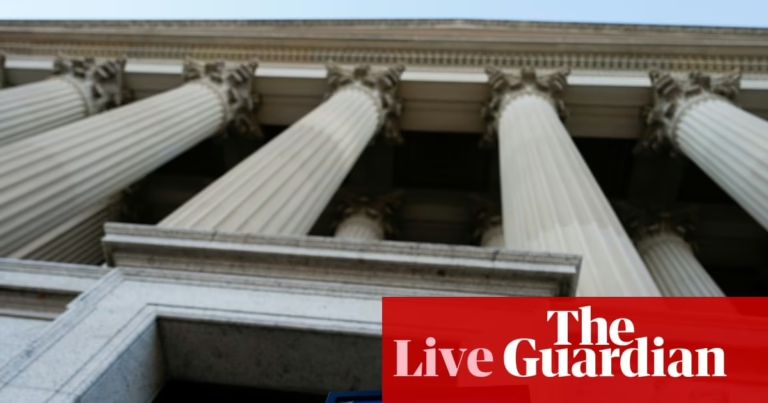Senate Rejects Democratic Proposal to Continue Government Funding
The Senate has voted 47-53 against the Democrats’ proposed continuing resolution to finance the government, with every Republican senator opposing the measure. The resolution fell short of the 60 votes required for approval.
Following this, the Senate is now considering the short-term spending bill passed by the House Republicans. This bill also demands a 60-vote threshold to pass and is anticipated to be unsuccessful.
Current Status of the Government Shutdown
More than half a day into the first federal government shutdown in nearly seven years, political tensions are escalating with no resolution in sight. The Supreme Court has also issued a significant ruling during this period, adding to the day’s developments.
- Deadlock persists: The Senate’s recent vote to dismiss the Democrats’ funding plan highlights the ongoing impasse. The chamber is now debating the Republican short-term funding proposal, which is also expected to fail due to insufficient support.
- White House messaging: The official White House website has been updated to emphasize the Trump administration’s stance that “Democrats have shut down the government.” A countdown clock has been added to track the duration of the shutdown.
- House recess: Speaker Mike Johnson announced that the House of Representatives will remain on recess until next week, aiming to increase pressure on Senate Democrats to accept the Republican funding plan.
- Senate Minority Leader’s response: Chuck Schumer defended the Democrats, noting that during previous standoffs under the Trump administration, Republicans were more willing to negotiate. He criticized the current lack of dialogue, stating that Republicans have refused to engage in talks this time.
- Speaker Johnson’s remarks: Johnson accused Schumer of relinquishing control to the executive branch to reduce government size and predicted significant political repercussions for Democrats.
- Impact on federal agencies: The shutdown raises concerns about how agencies like the Environmental Protection Agency will fulfill their responsibilities with limited staff and resources.
- Vice President Harris’s statement: Kamala Harris condemned the shutdown, attributing responsibility to President Trump and Congressional Republicans for refusing to curb rising healthcare costs, emphasizing that Republicans control all branches of government.
- Trigger for shutdown: The failure to reach a funding agreement before the new fiscal year began on October 1, 2025, led to the government shutdown.
White House Website Highlights Shutdown Duration
In a notable move, the White House revamped its website to underscore the Trump administration’s claim that Democrats are responsible for the government shutdown. The site features a live countdown clock tracking the shutdown’s length, which was initially launched to mark the minutes leading up to the shutdown.
The website also presents a collection of statements from various organizations, purportedly showing public disagreement with Democratic actions. However, most of these quotes, aside from a few from conservative groups, focus on the negative consequences of a shutdown and urge its avoidance rather than assigning blame.
House of Representatives to Remain in Recess Until Next Week
Speaker Mike Johnson confirmed that the House will not reconvene this week, citing completed work and the need to apply pressure on Senate Democrats to approve the Republican funding plan. He stated, “There is little we can accomplish on the floor while the government remains closed. Our priority is to reopen the government.”
Senate Minority Leader Schumer Criticizes GOP Negotiation Stance
Speaking on CNN, Senate Minority Leader Chuck Schumer responded to criticisms from Speaker Johnson and the White House, highlighting that previous government funding negotiations during the Trump administration involved bipartisan dialogue that prevented shutdowns.
“When I was majority leader, we voted on a budget 13 times. There was no shutdown because we negotiated with Republicans every time. Both sides made concessions,” Schumer explained.
He emphasized that this time, Republicans have refused to engage in negotiations despite repeated efforts from Democratic leaders, including House counterpart Hakeem Jeffries.
Russell Vought, the director of the Office of Management and Budget, is slated to conduct a conference call with House Republicans at 1pm ET to outline the next steps following the government shutdown, according to multiple news sources.
Republican members anticipate that Vought will update them on the directive he issued to federal agencies to initiate shutdown procedures, as well as discuss the widespread layoffs the Trump administration has indicated it may implement during this period.
During a press briefing in the Oval Office yesterday, President Trump remarked:
“We have the ability to take irreversible actions during the shutdown,” he said, “actions that will negatively impact them and cannot be undone by them,” including significant workforce reductions and the elimination of programs they favor.
House Speaker Mike Johnson told Fox Business this morning that Senate Democratic leader Chuck Schumer has effectively “handed over the keys” to the executive branch, enabling a reduction in the size and scope of government. Johnson described the shutdown as a “major setback” for Democrats.
Commenting on the Office of Management and Budget’s instructions for federal agencies to prepare for extensive layoffs amid the shutdown, Johnson stated:
“Although a shutdown causes real harm to Americans who rely on government services, it also presents a chance to streamline government operations, which has long been a goal. In effect, Chuck Schumer has now empowered the executive branch under President Trump to implement measures that would otherwise lack Democratic support.”
Johnson added that Russell Vought now has the authority to determine which services are essential, which programs should continue, and which are not priorities for taxpayers.
“This is the situation unfolding, and Schumer has allowed it to happen. Politically, this represents a significant blowback for him.”
He further noted, “There is now a genuine opportunity to make government more efficient and responsive to the public if these decisions are handled wisely.”
You can view the full clip here.
In a joint statement released early this morning, Senate Democratic leader Chuck Schumer and House Democratic leader Hakeem Jeffries accused Donald Trump and Republicans of causing the federal government shutdown because they refuse to safeguard Americans’ healthcare.
They emphasized their party’s willingness to “seek a bipartisan solution to reopen the government” but reiterated that the Republican position on healthcare remains a significant obstacle. “We need a trustworthy partner,” they insisted.
They also criticized President Trump’s recent conduct, describing it as increasingly erratic and unstable. Instead of engaging in sincere bipartisan negotiations, they said, he has been fixated on sharing bizarre deepfake videos.
The full statement reads:
“After months of policies that have made life more difficult and costly, Donald Trump and Republicans have now forced a federal government shutdown because they refuse to protect the healthcare of the American people. Democrats remain ready to pursue a bipartisan path to reopen the government in a way that reduces costs and addresses the Republican healthcare crisis. But we need a credible partner.
In recent days, President Trump’s behavior has become more erratic and unhinged. Rather than negotiating in good faith, he is obsessively posting bizarre deepfake videos.
The nation urgently requires intervention to end another Trump-induced shutdown.”
The government shutdown raises serious concerns about the Environmental Protection Agency’s (EPA) ability to fulfill its mission of safeguarding public health and the environment with only minimal staff and limited funding, as reported by the Associated Press.
During President Trump’s second term, the EPA has aggressively pursued deregulation and promoted fossil fuel industries such as oil, gas, and coal, citing an energy emergency.
Jeremy Symons, a former EPA policy advisor under President Bill Clinton, expressed apprehension that the shutdown could embolden the nation’s worst polluters to exploit the lack of oversight and discharge toxic pollutants unchecked.
“With the EPA shuttered, no one will be monitoring polluters for what they release into the air we breathe and the water we drink,” said Symons, now a senior adviser to the Environmental Protection Network, a coalition of former EPA officials advocating for a robust environmental agency.
A scientific analysis of emissions from approximately 200 coal-fired power plants during the 2018-2019 shutdown revealed a significant increase in particulate matter emissions due to EPA furloughs. This soot pollution is linked to thousands of premature deaths annually in the United States.

The EPA’s shutdown protocol mandates halting non-criminal pollution inspections essential for enforcing clean air and water regulations. It will suspend issuing new grants to other government bodies, updating its website, processing new permits, approving state pollution control requests, and most scientific research. Work on Superfund cleanup sites will cease except where public health is at immediate risk.
Marc Boom, a former EPA policy official during the Biden administration, noted that inspections under the Chemical Accident Risk Reduction program, which ensures facilities manage chemical accident risks under the Clean Air Act, will be suspended.
“Communities near these facilities will face increased risk exposure immediately, as the likelihood of accidents rises,” Boom warned.
He also mentioned that EPA hotlines for reporting water and other pollution issues will likely be closed. “If your water quality deteriorates later this week, there will be no one at the EPA to answer your call,” he added.
Although many airport workers, including air traffic controllers, are deemed essential and must continue working during the shutdown, they will not receive pay, which is expected to cause staffing shortages and potential travel disruptions both domestically and internationally.
How will air travel be affected?
While flights will operate, significant delays and cancellations are anticipated. Essential personnel such as air traffic controllers and Transportation Security Administration (TSA) agents will work without compensation. Past shutdowns have seen major flight disruptions and long security lines.
The shutdown may also impact the Federal Aviation Administration’s (FAA) air traffic control system. Despite recruiting 2,000 new controllers in 2025, their training programs are likely to be interrupted by the shutdown.
What about rail services?
Amtrak services will continue to operate despite the government shutdown. While Amtrak benefits from federal funding, it primarily sustains itself through its own revenue streams, meaning it is not immediately reliant on government appropriations. However, if the shutdown persists for an extended period, Amtrak’s operations could eventually face disruptions.

What about passports and visas?
A spokesperson from the State Department assured CNN that consular services, both within the United States and abroad, will remain fully operational. This includes the processing of passports, visas, and providing assistance to American citizens overseas.
What would it take to resolve the US government shutdown?
The ongoing deadlock between former President Donald Trump and congressional Democrats has stalled any agreement on federal funding, resulting in the current shutdown. So, what are the key demands from each side to bring this impasse to an end?
Republican Priorities
With Republicans holding the majority in both the House and Senate, they have already secured significant budgetary victories this year. The comprehensive spending package passed in July increased funding for defense and immigration enforcement, reduced allocations for green energy initiatives and other Democratic priorities, and implemented substantial cuts to Medicaid programs serving low-income and disabled populations. These cuts were intended to offset tax reductions primarily benefiting wealthier Americans. Additionally, Republicans have supported efforts to retract previously approved funds for foreign aid and public broadcasting, despite concerns about undermining Congress’s constitutional spending authority. They have expressed willingness to approve a continuing resolution that maintains current funding levels through November 21, providing additional time to negotiate a full-year budget.
Democratic Objectives
Although in the minority, Democrats hold crucial leverage in the Senate, where 60 votes are required to advance most legislation. They are leveraging this to advocate for the extension of enhanced healthcare subsidies under the Affordable Care Act (ACA). Their proposal aims to make permanent the expanded tax credits that are set to expire at year-end, broadening eligibility to include more middle-income families. Without these subsidies, millions of Americans who rely on ACA coverage could face steep increases in health insurance costs, according to analyses by the Kaiser Family Foundation.
Democrats also seek provisions in any funding legislation that would prevent the Trump administration from unilaterally disregarding ACA requirements or withholding funds temporarily. Furthermore, they want to reverse certain restrictions on ACA coverage introduced in the recent spending bill, which, while projected to extend health insurance to an additional seven million people by 2035, would increase federal healthcare spending by $662 billion over a decade. Republicans have indicated openness to addressing the expiring tax credits separately but accuse Democrats of attempting to use the stopgap funding bill to expand government healthcare subsidies to undocumented immigrants.
Political Reactions
Kamala Harris, the former Democratic vice president, criticized Republicans for the shutdown, posting on social media platform X:
“President Trump and Congressional Republicans just shut down the government because they refused to stop your health care costs from rising. Let me be clear: Republicans are in charge of the White House, House, and Senate. This is their shutdown.”

Understanding the Impact of a Government Shutdown
A government shutdown occurs when Congress fails to approve the necessary funding bills, compelling federal agencies to suspend operations. Employees deemed “non-excepted” are placed on unpaid furlough, while those classified as excepted-typically individuals responsible for safeguarding life and property-must continue their duties without immediate compensation until the shutdown concludes.
During this period, numerous federal services face interruptions or complete halts as agencies suspend all non-essential activities. This disruption affects a wide range of public services and government functions.
In today’s deeply divided political climate, with narrow margins in both chambers, the threat of shutdowns has become a recurring element in budget negotiations. Historically, last-minute agreements have often prevented funding gaps, but this time, no such compromise was reached.
Which Federal Agencies Continue to Operate and Which Are Affected?
Following the funding lapse, the White House Office of Management and Budget (OMB) issues directives to federal agencies to begin orderly shutdown procedures. This memo, sent out on Tuesday evening, instructs agencies to furlough “non-excepted” personnel. The Congressional Budget Office estimates that approximately 750,000 federal workers could be furloughed, with daily payroll costs around $400 million.
Critical roles such as FBI agents, CIA operatives, air traffic controllers, airport security personnel, and members of the Armed Forces remain on duty. Programs funded through mandatory spending, including Social Security and Medicare, continue uninterrupted, ensuring seniors receive their benefits and healthcare providers are reimbursed.
Each agency crafts its own shutdown blueprint, specifying which employees remain active and which are furloughed. For instance, the Department of Health and Human Services plans to furlough about 41% of its nearly 80,000 employees. The Centers for Disease Control and Prevention (CDC) will maintain surveillance of disease outbreaks, but research into health risks and preventive measures will be paused.
Research and patient care at the National Institutes of Health (NIH) will also be disrupted. While patients already enrolled in clinical trials at the NIH’s research hospital will continue receiving treatment, new patient enrollments and studies will be suspended except under exceptional circumstances.
The National Park Service has yet to announce whether it will close its more than 400 sites nationwide. During a previous 35-day shutdown in President Trump’s first term, many parks, including Yellowstone and Yosemite, remained open but faced challenges such as vandalism and unauthorized access due to limited staffing.
The Food and Drug Administration (FDA) warns that its capacity to protect public health will be severely hindered, with many operations delayed or halted. For example, the FDA will not process new drug applications or medical device submissions that require user fees during the shutdown.
Democratic Leaders Criticize Republicans for the Shutdown
Congresswoman Shontel Brown placed full responsibility for the shutdown on Donald Trump and the Republican Party. In a statement, she asserted:
“Washington Republicans have utterly failed to fulfill their duty to fund the government. House Republicans were absent from Washington this week as the shutdown loomed. This was not accidental; it was a conscious decision.”
“While we worked to protect healthcare, they chose to go on vacation.”
“With each day the shutdown continues, families, workers, and communities in Northeast Ohio bear the consequences: military personnel and federal employees miss paychecks, Social Security and veterans’ services face delays, and small business loans stall.”
Similarly, Congresswoman Jasmine Crockett condemned the Republicans’ actions on social media, stating:
“Make no mistake: Republicans control the House, Senate, and White House. This shutdown is their doing. They had every opportunity to govern responsibly but opted for chaos instead. The American people are the ones suffering.”
Understanding the US Government Shutdown: Why This Year’s Crisis Is Particularly Concerning
What Led to the Government Shutdown?
The US federal government entered a shutdown after failing to finalize a funding agreement before the new fiscal year began on October 1, 2025. Both Democrats and Republicans have been entrenched in a bitter standoff, blaming each other for the impasse. This deadlock has left hundreds of thousands of federal employees facing furloughs or potential layoffs.
Senate Democratic leader Chuck Schumer accused Republicans of attempting to “bully” Democrats by refusing to negotiate on extending healthcare benefits and other key priorities. Conversely, Senate Majority Leader John Thune stated that Republicans would not be “held hostage” by Democratic demands.
Just hours before the shutdown, former President Donald Trump indicated that mass layoffs of federal workers might be necessary if no deal was reached, citing concerns over illegal immigration and healthcare costs as reasons for his stance.
Duration and Historical Context of Government Shutdowns
The length of this shutdown remains uncertain. The longest recent shutdown occurred in 2018 during Trump’s first term, lasting 34 days. During that period, approximately 800,000 of the federal government’s 2.1 million employees were furloughed without pay, highlighting the significant impact such shutdowns can have on the workforce.
Why Is This Shutdown More Severe?
This year’s shutdown poses a heightened threat to federal employees. The White House Office of Management and Budget (OMB) recently issued a directive instructing agencies to prepare not only for temporary furloughs but also for permanent layoffs if the shutdown persists. This marks a stark escalation compared to previous shutdowns.
The OMB’s memo specifically targets programs whose funding would lapse and are deemed inconsistent with the administration’s priorities. This move aligns with earlier efforts to reduce the federal workforce as part of a broader government efficiency initiative.
President Trump has publicly stated that shutdowns can be beneficial, suggesting they provide an opportunity to eliminate programs he opposes, particularly those associated with Democrats.
In response, House Minority Leader Hakeem Jeffries has vowed that Democrats will not be intimidated by threats of mass firings, directly challenging OMB Director Russell Vought’s approach. Additionally, two major federal employee unions have filed lawsuits against the administration, accusing it of unlawfully threatening widespread layoffs during the shutdown.
What Happens During a Government Shutdown?
When the government shuts down, hundreds of thousands of federal workers are either furloughed or required to work without pay. The Congressional Budget Office estimates that about 750,000 federal employees will be furloughed each day the shutdown continues.
Essential services such as Social Security, Medicare, military operations, immigration enforcement, and air traffic control continue to operate. Mail delivery and postal services also remain uninterrupted.
Other agencies release contingency plans outlining which operations will be affected. For example, the Department of Education plans to furlough nearly all its employees, while most of the Department of Homeland Security’s workforce will remain active.
National parks will stay partially accessible, with roads, trails, and open-air memorials generally open to visitors. However, past shutdowns have shown that such closures can lead to issues like increased litter, staffing shortages, and even tragic incidents.
The broader consequences of a shutdown can ripple through the economy, disrupting tourism, delaying food safety inspections, slowing air travel, and postponing immigration hearings. While immediate economic effects may be limited, prolonged shutdowns risk slowing growth, unsettling markets, and eroding public confidence.
Political Dynamics and Next Steps
The Senate recently rejected a Democratic proposal to fund the government, with a 47-53 vote falling short of the 60 votes needed. The chamber is now considering a Republican short-term spending bill, which also requires 60 votes and is expected to fail.
Meanwhile, the House of Representatives will remain in recess until next week, as announced by Speaker Mike Johnson. This decision aims to increase pressure on Senate Democrats to accept the Republican funding plan.
Johnson expressed skepticism about the Senate’s ability to act, noting that “there is nothing truly that we can do much on the floor while the lights are almost literally out here.”
The White House website has been updated to emphasize the administration’s position that “Democrats have shut down the government,” featuring a countdown clock tracking the shutdown’s duration. However, some of the statements highlighted on the site focus more on the shutdown’s impact rather than assigning blame.
Notable Reactions and Developments
Longtime Democratic Senator Dick Durbin of Illinois recently declined an honor from the Catholic Archdiocese of Chicago due to controversy over his support for abortion rights. Pope Leo XIV, originally from Chicago, criticized Trump’s immigration policies, questioning their alignment with Catholic pro-life values.
Durbin, who announced he will not seek re-election in 2026 after nearly three decades in the Senate, has been a prominent advocate for immigration reform.
US Government Shutdown Update: Senate Rejects Democratic Funding Proposal as House Speaker Announces Return Next Week
At present, there is no indication of progress from either political faction involved in the ongoing government funding impasse.
Senate Majority Leader John Thune emphasized that he opposes tying healthcare reform discussions to the government funding bill. He stated, “The resolution will come when Senate Democrats approve the legislation already passed by the House.”
Thune accused the Democrats of “holding the federal government hostage to their partisan agenda,” asserting that Republicans will refrain from bipartisan negotiations as long as this tactic continues.
During his remarks, Thune declared, “Democrats have capitulated to the far-left faction and effectively caused the government shutdown.”
Senate Minority Leader Chuck Schumer responded by urging Republicans to collaborate on resolving the healthcare crisis, suggesting that such cooperation could swiftly end the shutdown. “Democrats are eager to resolve this and improve healthcare immediately,” he affirmed.
Schumer criticized former President Trump, labeling him “the most juvenile president in history,” and condemned his approach to the healthcare issue. Instead of mature leadership, Schumer said, Trump “is threatening to harm countless hardworking Americans.”
Highlighting the Democrats’ willingness to negotiate, Schumer remarked, “Our proposals to lower insurance premiums and strengthen healthcare simply echo the desires of the American public. They want genuine solutions that alleviate their financial burdens.”



















